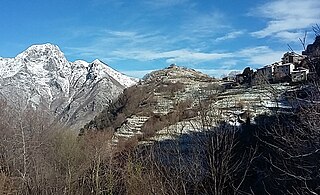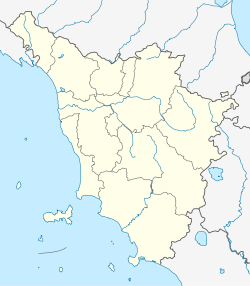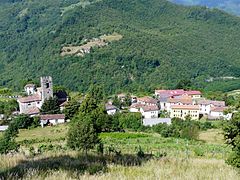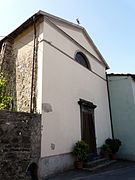The Garfagnana is a historical and geographical region of central Italy, today part of the province of Lucca, in Tuscany. It is the upper valley or basin of the river Serchio, and thus lies between the main ridge of the Northern Apennines to the north-east and the Alpi Apuane to the west. The principal towns are Castelnuovo di Garfagnana and Barga.

The province of Lucca is a province in the Tuscany region of Italy. Its capital is the city of Lucca.

Barga is a medieval town and comune of the province of Lucca in Tuscany, central Italy. It is home to around 10,000 people and is the chief town of the "Media Valle" of the Serchio River. It is a member of the I Borghi più belli d'Italia association.

The Serchio is the third longest river in the Italian region of Tuscany at 126 kilometres (78 mi), coming after the Arno at 242 kilometres (150 mi) and the Ombrone, 161 kilometres (100 mi). By mean rate of flow, it is the second largest, smaller than Arno but larger than Ombrone.

Borgo a Mozzano is a town and comune in the province of Lucca, in northern Tuscany (Italy), located on the Serchio River.
Castelnuovo or Castel Nuovo may refer to :

Camporgiano is a comune (municipality) in the Province of Lucca in the Italian region Tuscany, located about 90 kilometres (56 mi) northwest of Florence and about 40 kilometres (25 mi) northwest of Lucca.

Coreglia Antelminelli is a comune (municipality) in the Province of Lucca in the Italian region Tuscany, located about 70 kilometres (43 mi) northwest of Florence and about 25 kilometres (16 mi) north of Lucca.

Gallicano is a comune (municipality) in the Province of Lucca in the Italian region Tuscany, located about 70 kilometres (43 mi) northwest of Florence and about 25 kilometres (16 mi) northwest of Lucca.

Molazzana is a comune (municipality) in the Province of Lucca in the Italian region Tuscany, located about 70 kilometres (43 mi) northwest of Florence and about 25 kilometres (16 mi) northwest of Lucca.

Pescaglia is a comune (municipality) in the Province of Lucca in the Italian region Tuscany, located about 70 kilometres (43 mi) northwest of Florence and about 15 kilometres (9 mi) northwest of Lucca.

Pieve Fosciana is a comune (municipality) in the Province of Lucca in the Italian region Tuscany, located about 80 kilometres (50 mi) northwest of Florence and about 30 kilometres (19 mi) north of Lucca.

Villa Collemandina is a comune (municipality) in the Province of Lucca in the Italian region Tuscany, located about 80 kilometres (50 mi) northwest of Florence and about 35 kilometres (22 mi) north of Lucca.
Santi Pietro e Paolo is the Baroque-style Roman Catholic cathedral in the center of the town of Castelnuovo di Garfagnana, region of Tuscany, Italy.
The following is a timeline of the history of the city of Pisa in the Tuscany region of Italy.

The Chapel of Our Lady's Assumption into Heaven, sometimes spelled as Chapel of Our Lady and also known as Little Church, is a church located in Retignano, a village in the municipality of Stazzema, Italy.

The Chiesa di San Nicola di Silanis is a church in a state of ruins in the comune of Sedini, northern Sardinia, Italy.

San Pellegrinetto was an Italian comune in the Alps of Garfagnana, a historic region of Tuscany, province of Lucca. It was dependent for many years on the comune of Trassilico, time during which it adopted the name Alpe di Trassilico until the creation of its parish. When Trassilico was incorporated as a fraction of Gallicano, so was San Pellegrinetto. It was eventually incorporated into the comune of Fabbriche di Vergemoli.




















